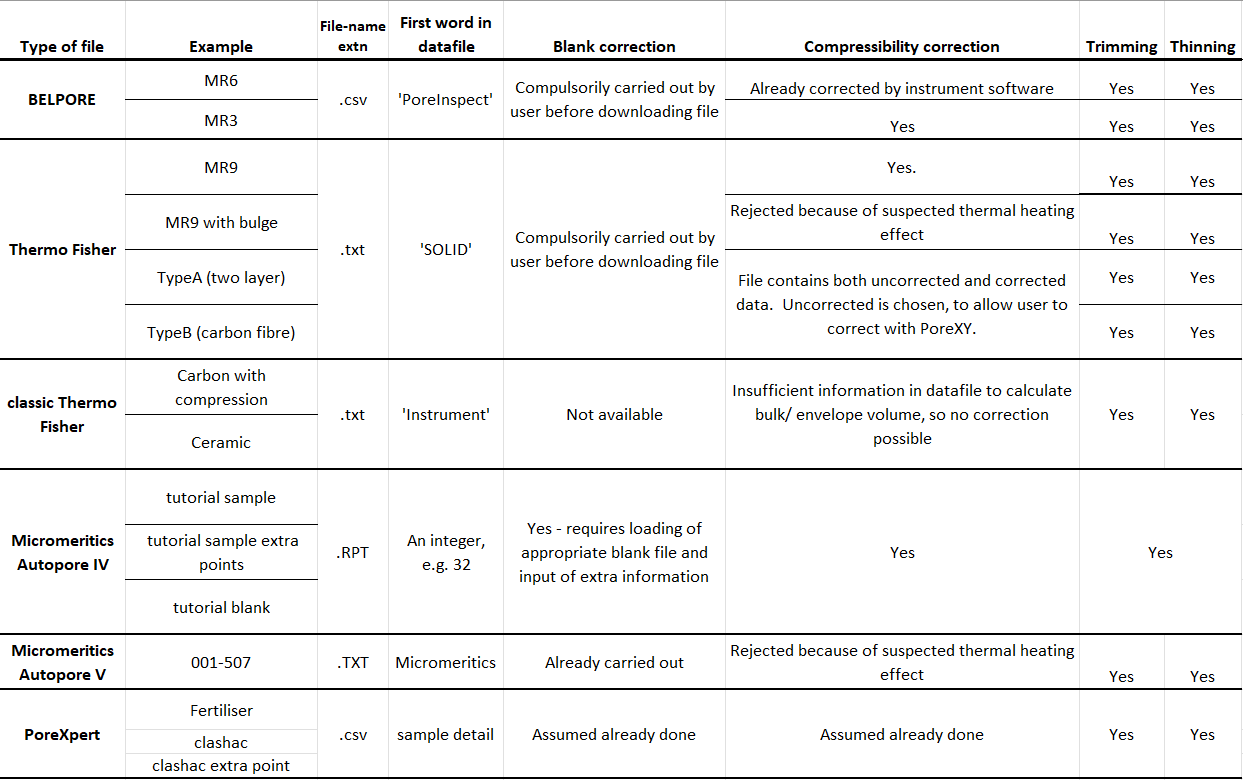Version
These instructions are for PoreXY version 2.1.50, scheduled for release in December 2022, with feature updates and upgrades as listed on its Change Log . If you do not have that version, then it can be downloaded free of charge by registering for downloads from the PoreXpert website.
Function
PoreXY, the successor to Pore-Comp and PoreXpand, is a processor for mercury porosimetry data that carries out six tasks, where applicable to the loaded experimental datafile:
(i) corrects for a run with an empty sample chamber - i.e. the blank run, thus correcting for sample chamber (penetrometer) expansion,
(ii) compares the porosity listed on the datafile with that calculated from the sample's bulk porosity and maximum intrusion volume,
(iii) allows easy examination of parts of the porosimetry curves by means of a zoom-in function,
(iv) corrects for sample solid phase compressibility, allowing for compression of mercury, and provides the user with the sample's solid phase bulk modulus,
(v) allows the user to trim the top and bottom of the intrusion curve if necessary, as PoreXpert models the full intrusion curve that is input, and extra 0% or 100% intrusion points weaken the model by extending the range of void sizes modelled beyond those that are valid,
(vi) thins the data so that the intrusion points are more equally spaced working along the intrusion curve, so that PoreXpert equally weights statistically all parts of the curve - rather than, say, being equally spaced with regards to pressure, which gives fewer points, and therefore under-weighting, at the important point of inflexion.
Even if you do not use PoreXpert routinely, PoreXY can be useful. Quality control (but NOT void size estimation) can be carried by taking the first derivative (slope) of the intrusion curve, usually plotted with a logarithmic pressure (or size) axis. PoreXY outputs fewer and more equally spaced points, and therefore leads to easier measures of slope.
Input
As shown below, PoreXY inputs data from Thermo Fisher, BELPORE and Micromeritics Autopore III, IV and V mercury porosimeters. It also accepts PoreXpert csv format files, although they contain minimal information, so can only be trimmed and thinned.
Datafiles must be in UK format - specifically the decimal point separator must be a period / full stop (.) rather than a comma (,).
The example files below are loaded at instal time into a newly created directory named ...Documents/PoreXY/Tutorial Files .
Examples of the specific formats required are given in the PoreXpert Help for BELPORE, Thermo Fisher, Micromeritics and PoreXpert types. There is some limited degree of flexibility with regard to missing lines and columns of data if the software does not require them, as well as to data columns output in a different order.

Behaviour of the software
As can be seen above, the Tutorial Files provided with the software not only illustrate formats that can automatically be read in by PoreXY, but also the way it reacts to various types of data and options that were chosen by the user when they carried out the porosimetry, as follows:
(i) It is normally better to user the porosimeter 's own control software to correct for the blank run (i.e. mercury compression and sample chamber expansion). However, PoreXY can carry out the blank correction itself, as illustrated in the next two sections concerning sample input and blank correction for Micromeritics Autopore III and IV format files (using datafiles tutorial sample and tutorial blank).
(ii) If the datafile contains both data uncorrected for compressibility and the corresponding corrected data, PoreXY will choose to use only the uncorrected data, so that it can perform its own corrections (as illustrated by datafile TypeB).
(iii) If there is insufficient information within the datafile for a compression correction to be carried out, PoreXY will only allow itself to be used for trimming and thinning (as illustrated by the classic Thermo Fisher and PoreXpert datafiles).
(iv) If there is a suspected thermal heating effect, PoreXY will refuse to carry out a compression correction, since the result would be invalid, but will still allow trimming and thinning (as illustrated by the datafiles MR9 with bulge and 001-507).
Output
(i) PoreXY calculates the solid-phase bulk modulus (compressibility) of your sample (not the overall compressibility of the sample). The solid phase compressibility is useful if, for example, you have a paper coating specimen or a fuel cell substrate, and need to know whether the binder (e.g. latex or PTFE) is sitting between the substrate particles or network as well as coating them/it, or only acting as a coating.
(ii) The software outputs the processed data in the very simple PoreXpert format for direct entry into PoreXpert itself.
Caveat
The bulk modulus estimate derived from PoreXY demands that you have perfect porosimetry results, carried out slowly with no thermal heating effects, that are perfectly blank corrected. The accuracy of the estimate decreases for higher bulk moduli (lower compressibility) because the calculation becomes increasing affected by the accuracy of the experimental data. You are unlikely to obtain a meaningful estimate of sample with bulk modulus above 30 GPa. This decrease in accuracy is shown in the Results datafiles dropdown menu.
You need to follow best practice for mercury porosimetry to ensure you get good quality data. Not all of the recommendations are applicable to different instrument manufacturers.
Using PoreXY
To use PoreXY, carry out the relevant instructions that follow, in order. There is no separate tutorial - if you wish to try out the program before using one of your own samples, then try the datafile type example most similar to your own.
Background information
The theory behind the compression correction and bulk modulus calculation performed by PoreXY is explained in more detail in the Theory of compression correction page.